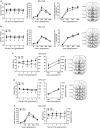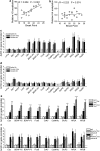Chronic cocaine-induced H3 acetylation and transcriptional activation of CaMKIIalpha in the nucleus accumbens is critical for motivation for drug reinforcement
- PMID: 20010550
- PMCID: PMC3055366
- DOI: 10.1038/npp.2009.193
Chronic cocaine-induced H3 acetylation and transcriptional activation of CaMKIIalpha in the nucleus accumbens is critical for motivation for drug reinforcement
Abstract
The regulation of gene expression in the brain reward regions is known to contribute to the pathogenesis and persistence of drug addiction. Increasing evidence suggests that the regulation of gene transcription is mediated by epigenetic mechanisms that alter the chromatin structure at specific gene promoters. To better understand the involvement of epigenetic regulation in drug reinforcement properties, rats were subjected to cocaine self-administration paradigm. Daily histone deacetylase (HDAC) inhibitor infusions in the shell of the nucleus accumbens (NAc) caused an upward shift in the dose-response curve under fixed-ratio schedule and increased the break point under progressive-ratio schedule, indicating enhanced motivation for self-administered drug. The effect of the HDAC inhibitor is attributed to the increased elevation of histone acetylation induced by chronic, but not acute, cocaine experience. In contrast, neutralizing the chronic cocaine-induced increase in histone modification by the bilateral overexpression of HDAC4 in the NAc shell reduced drug motivation. The association between the motivation for cocaine and the transcriptional activation of addiction-related genes by H3 acetylation in the NAc shell was analyzed. Among the genes activated by chronic cocaine experiences, the expression of CaMKIIalpha, but not CaMKIIbeta, correlated positively with motivation for the drug. Lentivirus-mediated shRNA knockdown experiments showed that CaMKIIalpha, but not CaMKIIbeta, in the NAc shell is essential for the maintenance of motivation to self-administered cocaine. These findings suggest that chronic drug-use-induced transcriptional activation of genes, such as CaMKIIalpha, modulated by H3 acetylation in the NAc is a critical regulatory mechanism underlying motivation for drug reinforcement.
Figures







Similar articles
-
Overexpression of CREB in the nucleus accumbens shell increases cocaine reinforcement in self-administering rats.J Neurosci. 2011 Nov 9;31(45):16447-57. doi: 10.1523/JNEUROSCI.3070-11.2011. J Neurosci. 2011. PMID: 22072694 Free PMC article.
-
Antidepressant actions of histone deacetylase inhibitors.J Neurosci. 2009 Sep 16;29(37):11451-60. doi: 10.1523/JNEUROSCI.1758-09.2009. J Neurosci. 2009. PMID: 19759294 Free PMC article.
-
HDAC3 Activity within the Nucleus Accumbens Regulates Cocaine-Induced Plasticity and Behavior in a Cell-Type-Specific Manner.J Neurosci. 2021 Mar 31;41(13):2814-2827. doi: 10.1523/JNEUROSCI.2829-20.2021. Epub 2021 Feb 18. J Neurosci. 2021. PMID: 33602824 Free PMC article.
-
mTORC1 inhibition in the nucleus accumbens 'protects' against the expression of drug seeking and 'relapse' and is associated with reductions in GluA1 AMPAR and CAMKIIα levels.Neuropsychopharmacology. 2014 Jun;39(7):1694-702. doi: 10.1038/npp.2014.16. Epub 2014 Jan 28. Neuropsychopharmacology. 2014. PMID: 24469593 Free PMC article.
-
Epigenetic Effects of Addictive Drugs in the Nucleus Accumbens.Front Mol Neurosci. 2022 Jun 23;15:828055. doi: 10.3389/fnmol.2022.828055. eCollection 2022. Front Mol Neurosci. 2022. PMID: 35813068 Free PMC article. Review.
Cited by
-
Disrupted Circadian Rhythms and Substance Use Disorders: A Narrative Review.Clocks Sleep. 2024 Aug 19;6(3):446-467. doi: 10.3390/clockssleep6030030. Clocks Sleep. 2024. PMID: 39189197 Free PMC article. Review.
-
Epigenetics of drug abuse: predisposition or response.Pharmacogenomics. 2012 Jul;13(10):1149-60. doi: 10.2217/pgs.12.94. Pharmacogenomics. 2012. PMID: 22909205 Free PMC article. Review.
-
Dysregulation of Acetylation Enzymes Inanimal Models of Psychostimulant use Disorders: Evolving Stories.Curr Neuropharmacol. 2016;14(1):10-6. doi: 10.2174/1570159x13666150121230133. Curr Neuropharmacol. 2016. PMID: 26813118 Free PMC article. Review.
-
Co-location of HDAC2 and insulin signaling components in the adult mouse hippocampus.Cell Mol Neurobiol. 2012 Nov;32(8):1337-42. doi: 10.1007/s10571-012-9859-6. Epub 2012 Jun 26. Cell Mol Neurobiol. 2012. PMID: 22733364 Free PMC article.
-
Alterations in AMPA receptor subunits and TARPs in the rat nucleus accumbens related to the formation of Ca²⁺-permeable AMPA receptors during the incubation of cocaine craving.Neuropharmacology. 2011 Dec;61(7):1141-51. doi: 10.1016/j.neuropharm.2011.01.021. Epub 2011 Jan 27. Neuropharmacology. 2011. PMID: 21276808 Free PMC article.
References
-
- Ahmed S, Koob G. Vertical shifts in dose–injection curves reflect reward allostasis, not sensitization. Psychopharmacology. 2004;171:354–355.
-
- Ahmed SH, Koob GF. Transition from moderate to excessive drug intake: change in hedonic set point. Science. 1998;282:298–300. - PubMed
-
- Ahmed SH, Walker JR, Koob GF. Persistent increase in the motivation to take heroin in rats with a history of drug escalation. Neuropsychopharmacology. 2000;22:413–421. - PubMed
-
- Anderson SM, Famous KR, Sadri-Vakili G, Kumaresan V, Schmidt HD, Bass CE, et al. CaMKII: a biochemical bridge linking accumbens dopamine and glutamate systems in cocaine seeking. Nat Neurosci. 2008;11:344–353. - PubMed
-
- Belin D, Everitt BJ. Cocaine seeking habits depend upon dopamine-dependent serial connectivity linking the ventral with the dorsal striatum. Neuron. 2008;57:432–441. - PubMed
Publication types
MeSH terms
Substances
LinkOut - more resources
Full Text Sources

